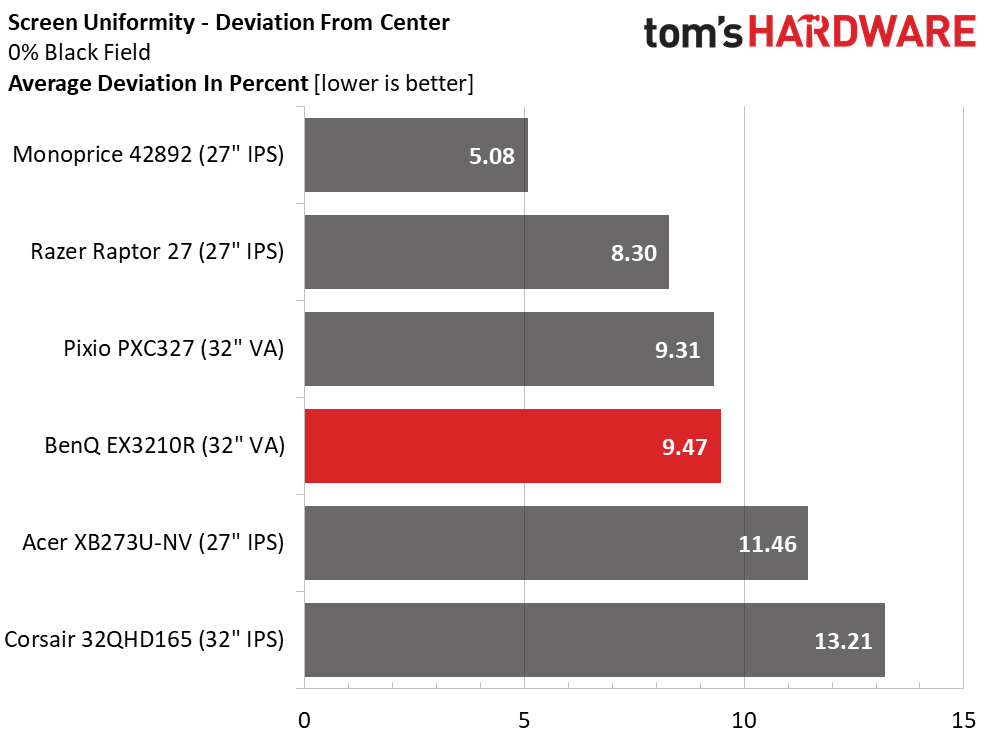Why you can trust Tom's Hardware
The EX3210R comparison group is all QHD with a mix of VA and IPS panels in either 32 or 27-inch sizes. For IPS, I’ve included the Razer Raptor 27, Monoprice’s 42892 and Acer’s XB273-NV. In the 32-inch format is the Corsair 32QHD165 and Pixio PXC327. Speeds range from 165 to 180 Hz.
Pixel Response and Input Lag
Click here to read up on our pixel response and input lag testing procedures.


You won’t find much visual difference between 165, 170 and 180 Hz. In this test, all monitors draw a full white screen in six milliseconds, except for the Pixio, which takes eight. I’ve observed that even a one millisecond difference in this test makes an impact on motion resolution both in test patterns and in actual content. The EX3210R is on par for that metric.
In the total lag test, the BenQ is slightly behind the others. You won’t perceive a difference in control response between the bottom three screens but the Razer and Monoprice monitors feel a bit snappier. To a casual player like me, it’s not enough to distract, but more skilled gamers than I will prefer the faster displays. The EX3210R worked well for my gameplay and never faltered in fast-paced action sequences.
Viewing Angles
The EX3210R’s VA panel looks better off-axis than most though it will never be taken for an IPS monitor. Light falloff to the sides is minimal at just 20%. But a color shift in the middle brightness steps can clearly be seen. Interestingly, the same thing happens in the vertical plane. Detail remains well rendered, but you’ll enjoy this BenQ best when sitting in the center seat.
Screen Uniformity
To learn how we measure screen uniformity, click here.
The EX3210R manages to crack the 10% threshold in the uniformity test. That means there are no visible hotspots, bleed or glow in this sample. Other EX3210Rs may exhibit different results, but this one looked perfectly uniform in a completely dark room when displaying a full-screen black pattern.
Get Tom's Hardware's best news and in-depth reviews, straight to your inbox.
Current page: Response, Input Lag, Viewing Angles and Uniformity
Prev Page Features and Specifications Next Page Brightness and Contrast
Christian Eberle is a Contributing Editor for Tom's Hardware US. He's a veteran reviewer of A/V equipment, specializing in monitors. Christian began his obsession with tech when he built his first PC in 1991, a 286 running DOS 3.0 at a blazing 12MHz. In 2006, he undertook training from the Imaging Science Foundation in video calibration and testing and thus started a passion for precise imaging that persists to this day. He is also a professional musician with a degree from the New England Conservatory as a classical bassoonist which he used to good effect as a performer with the West Point Army Band from 1987 to 2013. He enjoys watching movies and listening to high-end audio in his custom-built home theater and can be seen riding trails near his home on a race-ready ICE VTX recumbent trike. Christian enjoys the endless summer in Florida where he lives with his wife and Chihuahua and plays with orchestras around the state.

